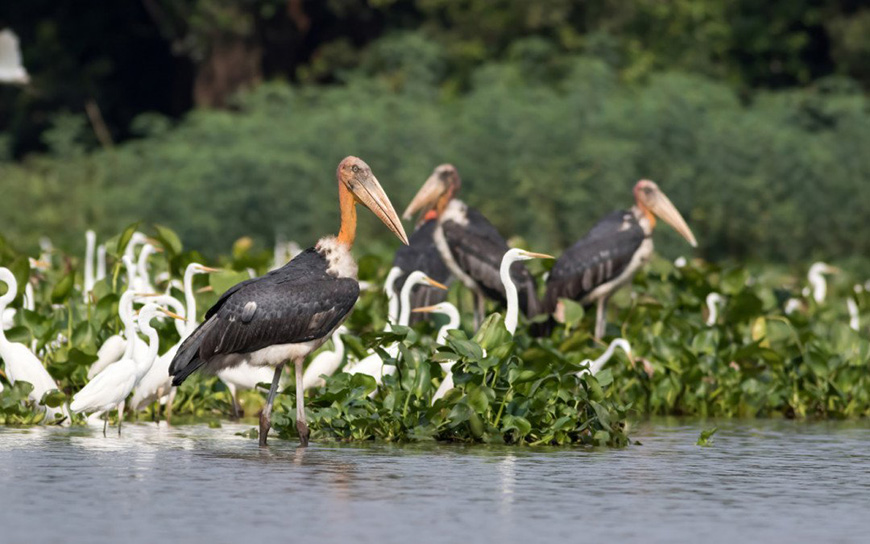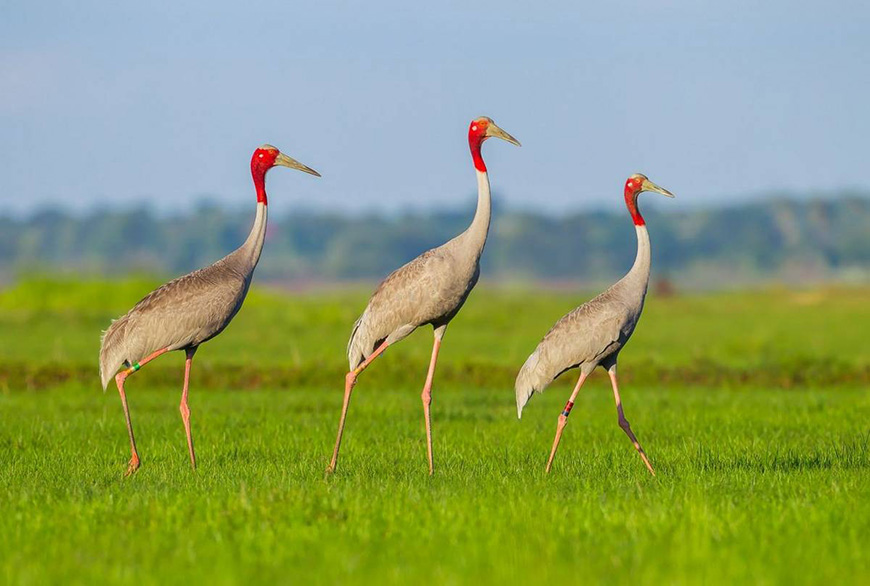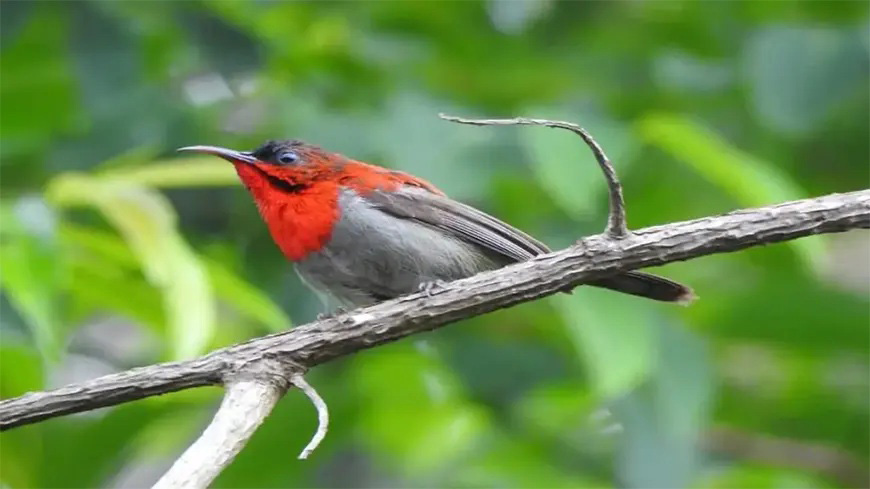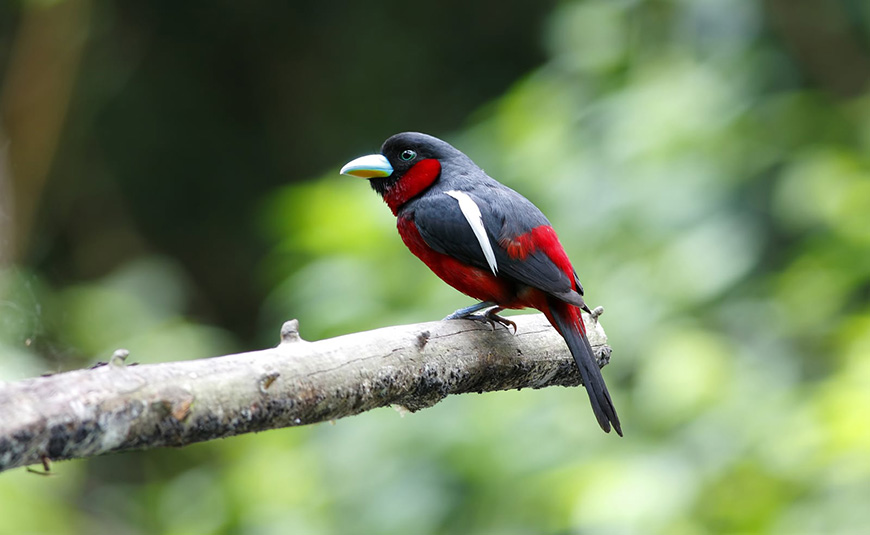Introduction
Cambodia, renowned for its natural beauty and rich cultural heritage, is also a prime destination for ornithology enthusiasts. This Southeast Asian kingdom boasts
exceptional biodiversity and is home to a spectacular avifauna of over 670 species. From lush tropical forests to vast wetlands and grassy plains, Cambodia's varied ecosystems provide a unique habitat for an impressive diversity of birds. Whether you are a seasoned ornithologist or a simple bird lover, the
Kingdom of Wonders promises an unforgettable experience.
 Prek Toal provides an ideal habitat for numerous species (hHere : Greater Adjutant) - Internet
Prek Toal provides an ideal habitat for numerous species (hHere : Greater Adjutant) - InternetThe best destinations for bird watching in Cambodia
Prek Toal bird sanctuary
Located at the northwest end of
Lake Tonle Sap, Prek Toal is recognized as the most important breeding site for large waterbirds in Southeast Asia. At the heart of the
Tonle Sap Biosphere Reserve, this protected area provides an ideal habitat for numerous species, some of which are threatened globally. Visitors can observe iconic species such as the Spot-billed Pelican, the Greater Adjutant, and the Black-headed Ibis, as well as significant populations of adjutants and Milky Storks. The experience begins with a scenic boat trip across the Tonle Sap Lake, offering a fascinating glimpse of local life and floating villages. In the sanctuary, observers are rewarded with spectacular views of waterbird colonies nesting in flooded trees.
Good to know: The dry season, from December to May, is the ideal time to visit Prek Toal, as water levels are low and concentrate the birds, offering optimal viewing conditions.
Kulen Promtep wildlife sanctuary
In the heart of the vast plains of northern Cambodia lies the isolated village of Tmatboey. A unique site, globally recognized as the only place where the Giant Ibis and White-shouldered Ibis reliably breed and can be observed. These two critically endangered species make Tmatboey a site of paramount importance for bird conservation. The surrounding landscape consists of dry dipterocarp forests, seasonal wetlands, and vast grasslands. In addition to the ibis, the area is home to vultures, the Greater Adjutant, and the Sarus Crane. Tmatboey is also a successful example of community-based ecotourism, with ecolodges managed by the local population and expert ornithological guides.
Good to know: The best time to observe the ibis in Tmatboey is from January to April, during the dry season.
 Sarus Crane at Ang Trapeang Thmor Reservoir - Internet
Sarus Crane at Ang Trapeang Thmor Reservoir - InternetAng Trapeang Thmor reservoir (ATT)
Ideally located between Siem Reap and Battambang, this site is essential for the conservation of the Sarus Crane. During the dry season, from December to May, ATT attracts a significant number of these birds. The varied landscape around the reservoir includes rice fields, wetlands, and dipterocarp forests, supporting a rich diversity of birds, with nearly 198 species recorded. Observers can spot birds of prey, starlings, ducks, and large water and grassland birds. ATT is particularly renowned for its Sarus Crane sightings, the tallest flying crane in the world.
Keo Seima wildlife sanctuary
The eastern plains of Cambodia are home to the vast Keo Seima Wildlife Sanctuary, a treasure trove of biodiversity that shelters an impressive variety of birds and mammals, including several species of gibbons. This protected site is prized by ornithologists for the richness of its avifauna, including the Germain's Peacock-pheasant, the Green Peafowl, the Crested Argus, and the Great Hornbill. Keo Seima is also renowned for its high concentration of woodpeckers, with more than 16 species recorded. The Jahoo Gibbon Camp offers an immersive experience in the heart of the sanctuary, where visitors can stay in the forest, observe gibbons, and discover the Bunong culture. The diversity of Keo Seima's ecosystems explains the richness of its avifauna, with more than 334 species recorded.
 Sunbird - Souimanga siparaja - in Keo Seima Wildlife Sanctuary - Internet
Sunbird - Souimanga siparaja - in Keo Seima Wildlife Sanctuary - InternetMount Bokor
In the Elephant Mountains of southern Cambodia, Mount Bokor offers a cooler climate and important habitats for interesting avifauna, notably the Chestnut-headed Partridge. Despite development, significant areas remain, providing refuge for this species and other forest birds. Nearby, the Kampot salt flats are home to a variety of shorebirds, such as the Eurasian Curlew, sandpipers, the Little Ringed Plover, and the Red-necked Phalarope. The combination of mountain and shorebird avifauna makes the Bokor and Kampot region an attractive destination.
Phnom Aural
At 1813 meters, the highest peak in Cambodia in the Cardamom Mountains, Phnom Aural, watches over remarkable biodiversity, including 200 species of birds. Among these is the Cambodian Laughingthrush, an endemic species. Exploring this remote mountain is a jungle adventure, requiring a sometimes difficult ascent and camping with local rangers. This unique experience offers the opportunity to observe bird species found nowhere else in Cambodia.
Around Tonle Sap
The seasonally flooded grasslands bordering the Tonle Sap Lake, known as florican grasslands, are home to more than half of the world's population of the Bengal Florican, a critically endangered species. These vast expanses are an essential habitat for the survival of this rare bird. Easily accessible from Siem Reap, the florican grasslands offer a rare opportunity to observe a bird on the brink of extinction and contribute to its conservation.
National parks and wildlife sanctuaries for bird enthusiasts
Let's conclude our discovery with the national parks and wildlife sanctuaries that are important for bird watching. Botum Sakor National Park stands out for its biodiversity and varied habitats, as does Virachey National Park, the largest in the country. AAnd, as mentioned above, the Kulen Promtep Wildlife Sanctuary is crucial for the conservation of certain species and also shelters a diversity of birds in its different ecosystems. These protected areas offer opportunities to observe a rich Cambodian avifauna.
 This extraordinary bird (Black and Red Broadbill) lives only in the tropical forests of Southeast Asia.
This extraordinary bird (Black and Red Broadbill) lives only in the tropical forests of Southeast Asia.Tips for bird watching in Cambodia
To optimize bird watching, favor the early morning and late afternoon, when birds are most active. Essential equipment includes quality binoculars, a reliable field guide, a notebook, neutral-colored clothing, and protection from the sun and insects. Using experienced local guides can greatly enrich the experience. It is crucial to respect the environment by maintaining a respectful distance, avoiding excessive noise, and leaving no trace. Bird watching requires patience, and taking the time to observe carefully can reveal hidden species.
The best time to watch birds in Cambodia
The dry season, from November to April, is the most favorable time for bird watching in Cambodia, with a pleasant climate and moderate temperatures. More specifically, the months from November to February offer relatively cool temperatures and clear skies, ideal for exploring natural and cultural sites and observing a wide variety of birds. The rainy season, from May to October, is less favorable due to frequent showers and high humidity but can offer interesting opportunities for nature lovers, with lush vegetation and fewer tourists.
Bird conservation efforts in Cambodia
Cambodia is home to several threatened bird species, such as the Giant Ibis, the White-shouldered Ibis, and the Bengal Florican, which are the subject of crucial conservation efforts. Organizations such as the
Wildlife Conservation Society (WCS) and
BirdLife International play a vital role in research, habitat protection, and the engagement of local communities. Responsible ecotourism directly contributes to these efforts by providing income to local communities, encouraging the protection of biodiversity, and raising awareness among visitors.
 Bar-bellied pitta is a bird species listed in The IUCN Red List of Threatened Species 2016 - Internet
Bar-bellied pitta is a bird species listed in The IUCN Red List of Threatened Species 2016 - InternetEmbark on your bird watching adventure in Cambodia!
Cambodia is an exceptional destination for bird watching, offering unique opportunities to observe rare and threatened species in magnificent landscapes. Whether you are a seasoned ornithologist or a simple nature lover, the richness of Cambodia's avifauna will amaze you. We encourage you to plan your trip and discover the natural wonders of this fascinating country, knowing that your visit can contribute to conservation efforts.
Set off on an unforgettable adventure to discover Cambodia's winged treasures!